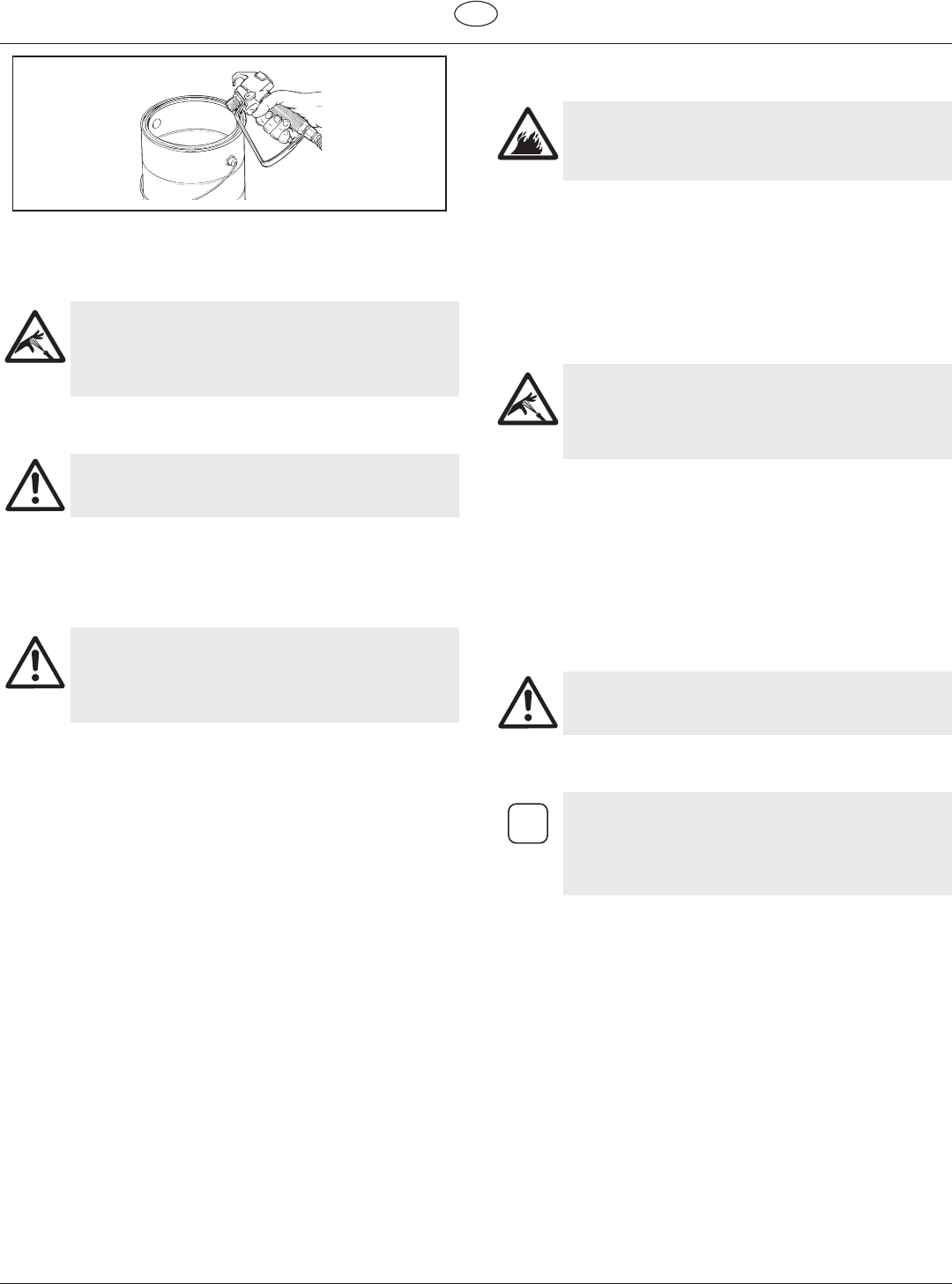
14. Unlockthegunbyturningtheguntriggerlocktothe
unlocked position.
Earth the gun by holding it against the edge of the
metal container while flushing. Failure to do so may
lead to a static electric discharge, which may cause
a fire.
15. Trigger the gun into the metal waste container until all air and
solvent is ushed from the spray hose and paint is owing
freely from the gun.
16. Lockthegunbyturningtheguntriggerlocktothelocked
position.
17. Close the shuto valve (g 11, item 1). The gure shows the
handle in the closed position.
18. Attach tip guard and tip to the gun as instructed by the tip
guard or tip manuals.
POSSIBLE INJECTION HAZARD. Do not spray
without the tip guard in place. Never trigger the
gun unless the tip is in either the spray or the unclog
position. Always engage the gun trigger lock before
removing, replacing or cleaning tip.
19. Open the shuto valve. The handle should now be in line
with the valve.
20. Increase the pressure by turning the air regulator slowly
clockwise and test the spray pattern on a piece of cardboard.
Adjust the regulator until the spray from the gun is completely
atomized.Verifypressurereadingattheairgauge.
• Paintpressureisdirectlyproportionaltotheamountofair
pressure.
• Example:PowrCoat30:1
100 PSI (6.9 bar) reading at air gauge = 3000 PSI (207 bar) at
pump outlet
DO NOT exceed an air regulator gauge reading of
100 PSI (6.9 bar).
21. Once the correct air pressure has been established, lock the air
regulator by pushing down on the knob.
i
Using a higher pressure than required will only
wear out tips. Use the guidelines in establishing the
lowest pressures for proper atomization.
Consult the materials manufacturer for guidelines in
establishing the correct uid pressure.
15. Trigger the gun into the metal waste container until the old
solvent is gone and fresh solvent is coming out of the gun.
16. Lockthegunbyturningtheguntriggerlocktothelocked
position.
POSSIBLE INJECTION HAZARD
Refer to your spray gun manual for information
regarding the locking mechanism and how to
properly lock the spray gun.
17. Set down the gun and increase the pressure by turning the air
regulator slowly clockwise to a maximum of 100 PSI (6.9 bar).
DO NOT exceed an air regulator gauge reading of
100 PSI (6.9 bar).
18. Check the entire system for leaks. If leaks occur, turn the
sprayer o and follow the “Pressure Relief Procedure” in this
manual before tightening any ttings or hoses.
19. Follow the “Pressure Relief Procedure” (section 4.6) in this
manual before changing from solvent to paint.
Be sure to follow the Pressure Relief Procedure when
shutting the unit down for any purpose, including
servicing or adjusting any part of the spray system,
changing or cleaning spray tips, or preparing for
cleanup.
4.5 Spraying
1. Place the siphon hose into a container of paint.
2. Place the bleed hose into a metal waste container.
3. Close the shuto valve (g 11, item 1). The gure shows the
handle in the closed position.
4. Turn on the air compressor.
5. Turn the air regulator (2) fully counterclockwise to its lowest
pressure setting.
6. Open the bleed valve (3) by turning it fully counterclockwise.
7. Open the shuto valve (g. 11, item 1). The handle should
now be in line with the valve.
8. Turn the air regulator (2) clockwise to increase pressure until
the sprayer cycles evenly and material ows freely from the
bleed hose.
9. Turn o the sprayer.
a. Turn the air regulator fully counterclockwise to its lowest
pressure setting.
b. Close the shuto valve.
10. Remove the bleed hose from the waste container and place it
into the container of material.
11. Close the bleed valve by turning it fully clockwise.
12. Open the shuto valve. The handle should now be in line
with the valve.
13. Turn the air regulator clockwise to increase pressure until the
sprayer cycles evenly. The air regulator gauge should read
between 60-80 PSI (4 - 5.5 bar).
PowrCoat 11
GB
Operation
